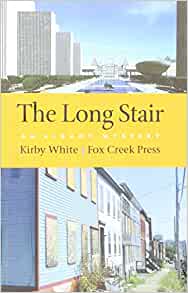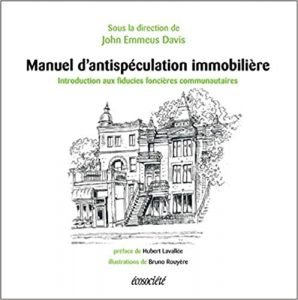 Manuel d'antispeculation immobiliere
Manuel d'antispeculation immobiliere
John Emmeus Davis and Michel Durand (translator), Ecosociete, 2014
DESCRIPTION: Puisant leurs racines dans la tradition autochtone et la pratique ancestrale des terres communales (commons) de la Nouvelle-Angleterre, les fiducies foncières communautaires (FFC) visent à développer un mode de propriété qui protège la terre au bénéfice de ceux et de celles qui y vivent et qui l’exploitent, et non pas de ceux et de celles qui l’acquièrent dans le seul but de s’enrichir. Les textes regroupés dans le Manuel d’antispéculation immobilière définissent le modèle des FFC et fournissent des outils pour mettre en branle ce type d’initiatives qui allient propriété collective de la terre et propriété individuelle du patrimoine bâti, tout en favorisant la mise en commun des gains résultant de l’effort collectif. L’ouvrage est bonifié par un aperçu de ce qui se fait à l’heure actuelle en Belgique et en France.
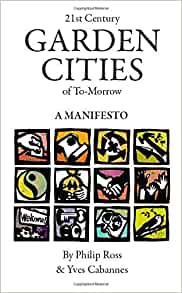 21st Century Garden Cities of To-morrow. A Manifesto
21st Century Garden Cities of To-morrow. A Manifesto
Philip Ross and Yves Cabannes. Hawthorne Press. 2014
DESCRIPTION: What is a Garden City? How do you become one? This book draws on the history of the garden city movement and the experience of Letchworth - the first Garden City where land was hold, and remains as a common. The book combines these experiments with contemporary international experiences and good practices to propose a manifesto for future garden cities.
It defines a Garden City as a place that brings together the best elements of town and country through the implementation of 12 core principles, that act as doors to transform a city, town or neighbourhood into a XXI Garden City: [1] Residents are citizens; [2] The Garden City owns itself; [3] The Garden City is energy efficient and carbon neutral; [4] Provides access to land for living and working to all; [5] Fair Trade principles are practised; [6] Prosperity is shared; [7] All citizens are equal, all citizens are different; [8] There is fair representation and direct democracy; [9] Garden Cities are produced through participatory planning and design methods; [10] A City of Rights that builds and defends the Right to the City; [11] Knowledge is held in common, shared and enhanced; [12] Wealth and harmony measured by happiness.
Written by Philip Ross, former Mayor of Letchworth Garden City and Em. Prof. Yves Cabannes, University College London. Foreword by Rod Hackney, former President of the Royal Institute of British Architects. Postscript by John Emmeus Davis, former Dean, National Community Land Trust Academy, USA.
- Download the PDF (with permission of the authors)
- Purchase on Amazon.com
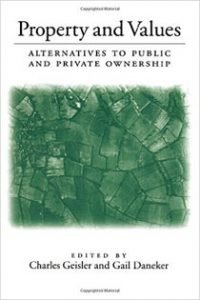 Property and Values: Alternatives to Public and Private Ownership
Property and Values: Alternatives to Public and Private Ownership
Charles Geisler and Gail Daneker (eds.). Washington DC: Island Press, 2000.
DESCRIPTION: The book synthesizes much innovative thinking on ownership in land and housing, and signals how that thinking might be used across America. Contributors – including David Abromowitz, Darby Bradley, Teresa Duclos, Sally Fairfax, Margaret Grossman, C. Ford Runge, William Singer and others – call for balance between property rights and responsibilities, between private and public rights in property, and between individual and societal interests in land.
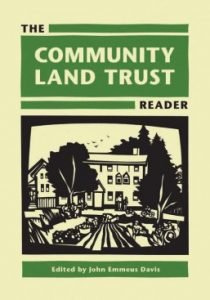 The Community Land Trust Reader
The Community Land Trust Reader
John Emmeus Davis (ed.). Cambridge MA: Lincoln Institute of Land Policy, 2010.
DESCRIPTION: This compendium brings together seminal and historical texts that inspired and defined the community land trust (CLT). The collection also examines contemporary applications of the CLT to promote home ownership, spur community development, protect public investment, and capture land gains for the common good.
 The Courage to Hope: How I Stood Up to the Politics of Fear
The Courage to Hope: How I Stood Up to the Politics of Fear
Shirley Sherrod. New York: Astra Books. 2012.
REVIEW BY WILLIE NELSON: “When I first met Shirley Sherrod, she was advocating for black farmers in Georgia. We needed her expertise for all farmers and she immediately jumped in to work with every farmer, no matter their color. [She] has always stood for equality, and she does not bow to fear. I am proud to have worked together with [her] in the movement to keep family farmers on the land, but I’m even more proud to call her my friend.”
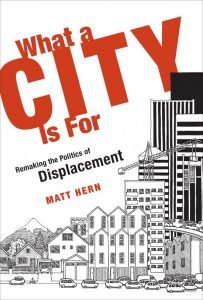 What a City Is For: Remaking the Politics of Displacement
What a City Is For: Remaking the Politics of Displacement
Matt Hern. Cambridge, MA: The MIT Press. 2016.
DESCRIPTION: Arguing that home ownership drives inequality, Matt Hern wants us to disown ownership. How can we reimagine the city as a post-ownership, post-sovereign space? Drawing on solidarity economics, cooperative movements, community land trusts, indigenous conceptions of alternative sovereignty, the global commons movement, and much else, Hern suggests repudiating development in favor of an incrementalist, non-market-driven unfolding of the city.

